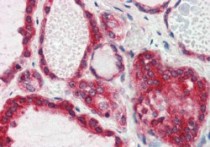ARG64050
anti-Lipin 3 antibody
anti-Lipin 3 antibody for IHC-Formalin-fixed paraffin-embedded sections and Human
Cell Biology and Cellular Response antibody; Metabolism antibody; Signaling Transduction antibody
Overview
| Product Description | Goat Polyclonal antibody recognizes Lipin 3 |
|---|---|
| Tested Reactivity | Hu |
| Tested Application | IHC-P |
| Host | Goat |
| Clonality | Polyclonal |
| Isotype | IgG |
| Target Name | Lipin 3 |
| Antigen Species | Human |
| Immunogen | C-KPKQKEDAVATD |
| Conjugation | Un-conjugated |
| Alternate Names | Lipin-3-like; EC 3.1.3.4; Phosphatidate phosphatase LPIN3; Lipin-3; SMP2; LIPN3L |
Application Instructions
| Application Suggestion |
|
||||
|---|---|---|---|---|---|
| Application Note | IHC-P: Antigen Retrieval: Steam tissue section in Citrate buffer (pH 6.0). * The dilutions indicate recommended starting dilutions and the optimal dilutions or concentrations should be determined by the scientist. |
Properties
| Form | Liquid |
|---|---|
| Purification | Purified from goat serum by ammonium sulphate precipitation followed by antigen affinity chromatography using the immunizing peptide. |
| Buffer | Tris saline (pH 7.3), 0.02% Sodium azide and 0.5% BSA |
| Preservative | 0.02% Sodium azide |
| Stabilizer | 0.5% BSA |
| Concentration | 0.5 mg/ml |
| Storage Instruction | For continuous use, store undiluted antibody at 2-8°C for up to a week. For long-term storage, aliquot and store at -20°C or below. Storage in frost free freezers is not recommended. Avoid repeated freeze/thaw cycles. Suggest spin the vial prior to opening. The antibody solution should be gently mixed before use. |
| Note | For laboratory research only, not for drug, diagnostic or other use. |
Bioinformation
| Database Links | |
|---|---|
| Background | Humans lipodystrophy is characterized by loss of body fat, fatty liver, hypertriglyceridemia, and insulin resistance. Mice carrying mutations in the fatty liver dystrophy (fld) gene have similar phenotypes. Through positional cloning, the mouse gene responsible for fatty liver dystrophy was isolated and designated Lpin1. The nuclear protein encoded by Lpin1 was named lipin. Lpin1 mRNA was expressed at high levels in adipose tissue and was induced during differentiation of preadipocytes. These results indicated that lipin is required for normal adipose tissue development and provided a candidate gene for human lipodystrophy. Through database searches, mouse and human EST and genomic sequences with similarities to Lpin1 were identified. These included two related mouse genes (Lpin2 and Lpin3) and three human homologs (LPIN1, LPIN2, and LPIN3). Human LPIN1 gene has been mapped to 2p25.; linkages of fat mass and serum leptin levels to this same region have been noted. Human LPIN2 and LPIN3 mapped to chromosomes 18p11 and 20q11-q12, respectively. The mouse genes encoding Lpin1, Lpin2, and Lpin3 mapped to chromosome 12, 17, and 2, respectively. [provided by RefSeq, Jul 2008] |
| Research Area | Cell Biology and Cellular Response antibody; Metabolism antibody; Signaling Transduction antibody |
| Calculated MW | 94 kDa |
Images (1) Click the Picture to Zoom In






